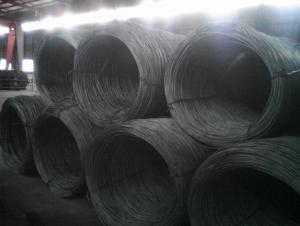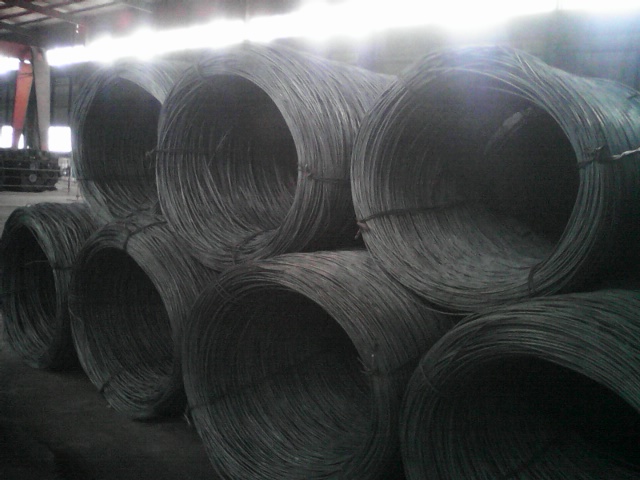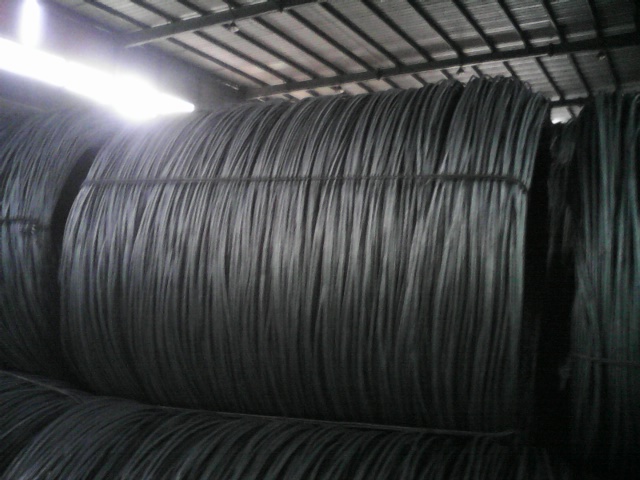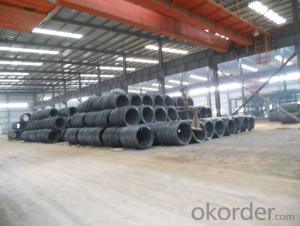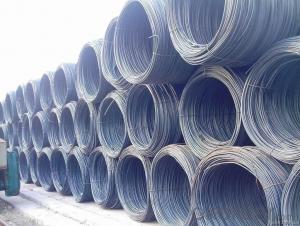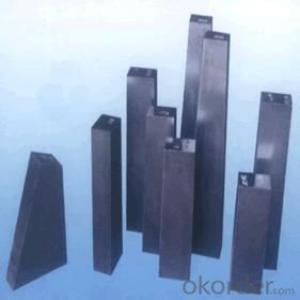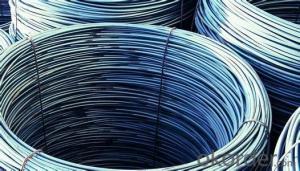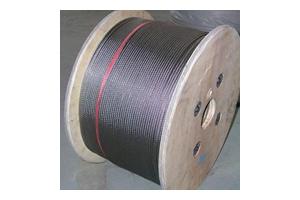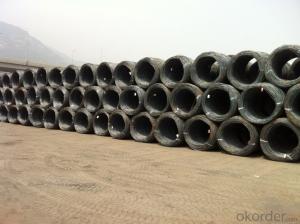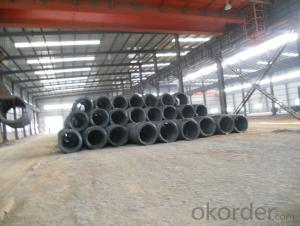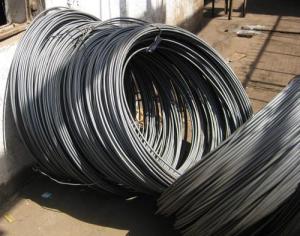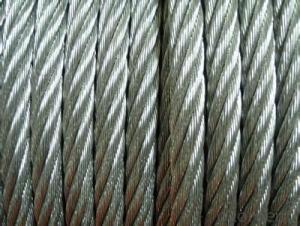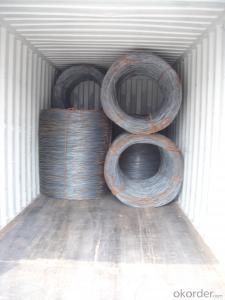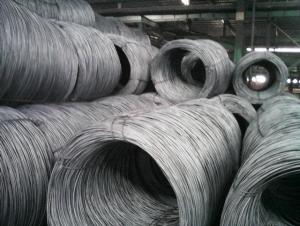Steel Wire Rod with High Quality for Construction
- Loading Port:
- China main port
- Payment Terms:
- TT or LC
- Min Order Qty:
- 25000 m.t.
- Supply Capability:
- 100000 m.t./month
OKorder Service Pledge
OKorder Financial Service
You Might Also Like
Product Description:
Specifications of Steel Wire Rod with High Quality for Construction:
Steel Grade: Q195/235B, SAE1006-1018B Standard: BS, GB
Diameter: 5.5mm, 6.5mm, 7mm,8mm,9mm,10mm,12mm,14mm
Diameter tolerance: ±0.3mm Type: Drawn Wire in coil, coil weight around 2MT
Technique: Hot Rolled Place of Origin: China Mainland
Surface: round, no twisted, light and smooth Brand Name: HSKY
Chemical Composition: (Please kindly find our chemistry of our material based on Q235B as below for your information)
Alloy No | Grade | Element(%) | ||||
C
| Mn | S
| P
| Si
| ||
Q235 |
B
|
0.12—0.20 |
0.3—0.7 |
≤0.045 |
≤0.045
|
≤0.3
|
Physical properties: (Please kindly find physical propertiesbased on Q235B as below for your information)
Alloy No | Grade | Yielding strength point( Mpa) | Tensile strength (Mpa) | Elongation after fracture(%) | ||||||
Thickness (mm) | Thickness (mm) | |||||||||
≤16 | >16--40 | >40--60 | >60-- 100 |
| ≤16 | >16-- 40 | >40-- 60 | >60-- 100 | ||
≥ | ≥ | |||||||||
Q235 |
B |
235 |
225 |
215 |
205 |
375--500 |
26 |
25 |
24 |
23 |
Usage and Applications of Steel Wire Rod with High Quality for Construction:
After hot-rolled the products shaped into coil and delivery as finished product, including round, square, rectangular, hexagonal and so on. Since most of the products are round, it is generally called wire rod. Carbon steel wire rod is widely used in construction and manufacturing. Carbon steel wire rod is mainly used for reinforcement of reinforced concrete and welded structure or reprocessed (roberts , nail, etc.) materials, especially used to produce wire drawing, welding electrode, nails, spring, electronic, precise machinery parts and so on.
Packaging & Delivery of Steel Wire Rod with High Quality for Construction:
Packaging Detail: products are packed in coil, each coil weight around 2 MT, and then shipped by container or bulk vessel
Delivery Detail: within 45 days after received deposit or LC.
Label: to be specified by customer, generally, each bundle has 1-2 labels
Trade terms: FOB, CFR, CIF
Low Carbon Steel Wire Rod in Container
FAQ:
Q1: Why buy Materials & Equipment from OKorder.com?
A1: All products offered byOKorder.com are carefully selected from China's most reliable manufacturing enterprises. Through its ISO certifications, OKorder.com adheres to the highest standards and a commitment to supply chain safety and customer satisfaction.
Q2: How do we guarantee the quality of our products?
A2: We have established an advanced quality management system which conducts strict quality tests at every step, from raw materials to the final product. At the same time, we provide extensive follow-up service assurances as required.
Q3: How soon can we receive the product after purchase?
A3: Within three days of placing an order, we will begin production. The specific shipping date is dependent upon international and government factors, but is typically 7 to 10 workdays.
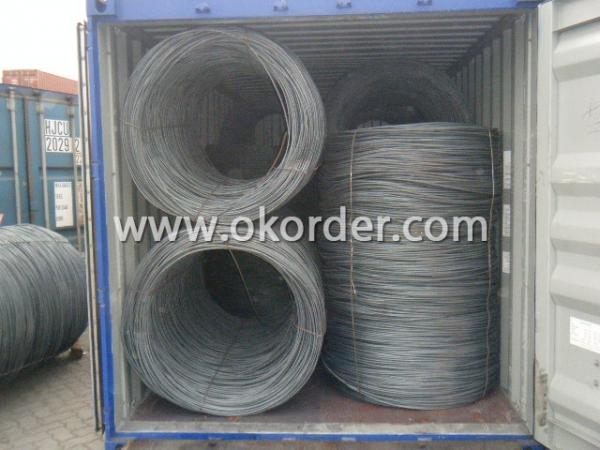
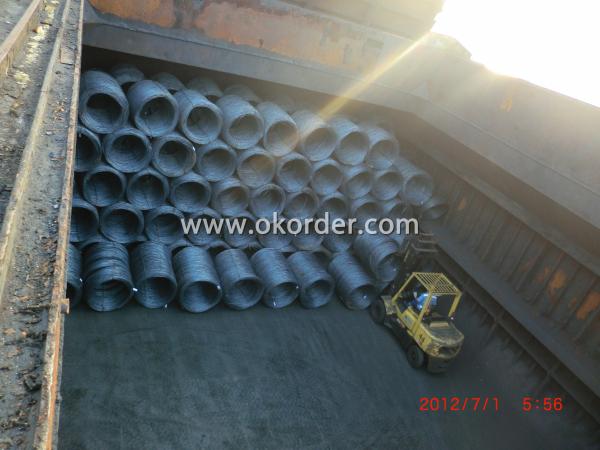
- Q: What are the applications of steel wire rod?
- Steel wire rods have a wide range of applications across various industries. They are commonly used in the construction industry for reinforcing concrete structures and providing strength to buildings and bridges. Steel wire rods are also utilized in the manufacturing of wire products such as cables, fencing, nails, and springs. Additionally, they find applications in the automotive and machinery sectors for making components like bolts, screws, and gears. Overall, steel wire rods play a crucial role in enhancing the durability, strength, and reliability of numerous products and structures.
- Q: How is steel wire rod used in the manufacturing of wire rope grips?
- The strength and durability of steel wire rod make it an essential component in manufacturing wire rope grips. These grips are crucial for securely connecting wire ropes, withstanding high tension and loads. To shape the steel wire rod into the desired diameter and smoothness, it is drawn through a series of dies during the manufacturing process. This process ensures that the wire rod possesses the necessary strength and flexibility to endure the demanding conditions faced by wire rope grips. After the wire rod is drawn and shaped, it undergoes further processing to create the wire rope grips. The rod is cut to the required length and then formed into a U-shape, creating a loop that securely holds the wire rope. The ends of the wire rod are threaded to facilitate easy tightening and loosening of the grip. High-quality carbon steel is typically used to manufacture the steel wire rod used in wire rope grips. This type of steel offers excellent strength and corrosion resistance, enabling the grips to endure heavy loads and harsh environmental conditions without compromising their integrity. In conclusion, steel wire rod is employed in the manufacturing of wire rope grips to provide the necessary strength, durability, and flexibility for securing and fastening wire ropes together. The use of high-quality carbon steel ensures that these grips can withstand demanding conditions and maintain their integrity over their lifespan.
- Q: How does the thermal conductivity of steel wire rod vary with different heat treatment processes?
- Different heat treatment processes can significantly affect the thermal conductivity of steel wire rod. Heat treatment is a method used to modify the physical and mechanical properties of steel, including its thermal conductivity. One commonly used heat treatment process is annealing. This process involves heating the steel wire rod to a specific temperature and then slowly cooling it. Annealing helps to alleviate internal stresses and enhance the steel's ductility and toughness. In terms of thermal conductivity, annealing can enhance it by reducing impurities and improving the crystal structure of the steel. As a result, there is improved heat transfer efficiency, leading to higher thermal conductivity. In contrast, quenching is a heat treatment process that rapidly cools the steel wire rod after heating it to a high temperature. This process is typically employed to increase the hardness and strength of the steel. However, quenching can also result in a decrease in thermal conductivity. The rapid cooling causes the formation of a fine-grained microstructure, which can hinder heat movement through the material. Another heat treatment process that affects the thermal conductivity of steel wire rod is tempering. Tempering is conducted after quenching and involves reheating the steel to a lower temperature before cooling it again. This process helps to reduce brittleness and improve toughness. Regarding thermal conductivity, the effect of tempering can vary depending on the specific temperature and duration of the process. Generally, tempering can slightly decrease the thermal conductivity of steel wire rod by promoting the formation of small carbide particles, which act as thermal barriers. Overall, the thermal conductivity of steel wire rod can be influenced by different heat treatment processes. Annealing typically increases thermal conductivity, while quenching and tempering may potentially decrease it. The specific parameters of the heat treatment, such as temperature, cooling rate, and duration, play a crucial role in determining the resulting thermal conductivity of the steel.
- Q: What are the safety requirements for steel wire rod used in mining wire ropes?
- The safety requirements for steel wire rod used in mining wire ropes are crucial to ensure the safe and reliable operation of mining equipment. These requirements are necessary to prevent accidents, injuries, and fatalities that may occur due to the failure of wire ropes. 1. Material Composition: The steel wire rod used in mining wire ropes must be manufactured from high-quality steel with specific properties to withstand the demanding conditions in mining operations. It should have a high tensile strength, excellent fatigue resistance, and good ductility. 2. Strength and Durability: The wire rod should meet specific strength requirements to ensure it can handle the load and stress associated with mining activities. It must be able to withstand heavy loads, sudden impacts, and repetitive bending and flexing without showing signs of fatigue or failure. 3. Surface Quality: The surface of the steel wire rod should be smooth and free from any cracks, deformations, or defects that could compromise the integrity of the wire rope. A rough or uneven surface can lead to increased friction, wear, and potential failures during operation. 4. Dimensional Accuracy: The wire rod should adhere to precise dimensional tolerances to ensure compatibility with other components of the wire rope system. Accurate dimensions are necessary for proper assembly, fitting, and functionality of the wire rope. 5. Heat Treatment: Proper heat treatment processes, such as annealing or quenching, should be applied to the wire rod to enhance its mechanical properties. Heat treatment can improve the strength, hardness, and resistance to wear and corrosion, making the wire rope more reliable and durable. 6. Quality Control: Rigorous quality control measures should be implemented during the manufacturing process to ensure the wire rod meets the specified safety requirements. Regular inspections, testing, and certifications should be carried out to verify the material's compliance with industry standards and regulations. 7. Documentation and Traceability: It is essential to maintain accurate documentation and traceability records for the steel wire rod used in mining wire ropes. This allows for proper tracking of the material's origin, manufacturing process, and quality control procedures, ensuring accountability and facilitating any necessary investigations or recalls. Adhering to these safety requirements for steel wire rod used in mining wire ropes is crucial to maintaining the integrity and reliability of the equipment. Regular inspection and maintenance of the wire ropes should also be conducted to ensure their continued safe operation.
- Q: How is steel wire rod used in the manufacturing of wire for electrical heating cables?
- Steel wire rod is an essential component in the manufacturing process of wire for electrical heating cables. The wire rod serves as the primary raw material that undergoes various treatments and transformations to produce the final electrical heating cable wire. To begin with, the steel wire rod is typically made from low-carbon steel, which possesses excellent electrical conductivity and heat resistance properties. This makes it an ideal material for electrical heating cables, as it can efficiently conduct electricity and withstand the high temperatures generated by the cables. The first step in the manufacturing process involves hot rolling the steel wire rod into a thin strip, which is then cold drawn to achieve the desired wire diameter. This cold drawing process imparts high tensile strength and flexibility to the wire, ensuring it can withstand the stress and strain associated with various applications. Once the wire is formed, it is then subject to a series of heat treatments to enhance its electrical conductivity and heat resistance. This may involve annealing, where the wire is heated and slowly cooled to relieve internal stresses and improve its ductility. Additionally, the wire may be subjected to a process called galvanization, which involves coating the wire with a protective layer of zinc to enhance its corrosion resistance. After the heat treatments, the wire is further processed to achieve the required specifications for electrical heating cables. This may involve additional drawing processes to achieve the desired diameter and surface finish. The wire is then wound onto spools or coils, ready to be used in the manufacturing of electrical heating cables. In the final stage of the manufacturing process, the steel wire is incorporated into the construction of electrical heating cables. This typically involves combining the wire with other materials, such as insulation and protective sheathing, to ensure the safety and functionality of the cables. Overall, steel wire rods play a crucial role in the manufacturing of wire for electrical heating cables. Its excellent electrical conductivity, heat resistance, and strength make it an ideal material for this application. Through various treatments and processes, the steel wire rod is transformed into a high-quality wire that can efficiently conduct electricity and withstand the demanding conditions of electrical heating systems.
- Q: What are the different wire drawing lubricants used for steel wire rod?
- There are several different wire drawing lubricants used for steel wire rod, including soap-based lubricants, oil-based lubricants, and synthetic lubricants. Soap-based lubricants are commonly used for mild steel wire rod, as they provide good lubrication and cooling properties. Oil-based lubricants are often used for high carbon and alloy steel wire rod, as they offer better lubrication and reduce friction during the drawing process. Synthetic lubricants, such as water-based polymer lubricants, are also used to improve surface finish and reduce wear on the wire rod during drawing.
- Q: How is steel wire rod priced in the market?
- Steel wire rod is priced in the market based on various factors that influence its production and demand. These factors include the cost of raw materials, such as iron ore and scrap metal, as well as the cost of energy and labor involved in the manufacturing process. Additionally, market conditions and supply and demand dynamics also play a significant role in determining the price of steel wire rod. Factors such as global economic conditions, trade policies, and infrastructure development projects can impact the demand for steel wire rod, thereby affecting its price. Steel wire rod is often traded on commodity exchanges, where market participants engage in buying and selling contracts based on future delivery dates. The price of steel wire rod on these exchanges is influenced by factors such as market speculation, storage costs, and transportation expenses. Furthermore, the quality and specifications of the steel wire rod also influence its price. Different grades, sizes, and coatings of steel wire rod have varying prices based on their suitability for different applications and industries. Overall, steel wire rod prices are determined by a combination of factors including raw material costs, production expenses, market conditions, supply and demand dynamics, quality specifications, and trading activities on commodity exchanges.
- Q: What are the common production processes for high carbon steel wire rod?
- The common production processes for high carbon steel wire rod include hot rolling, heat treatment, and surface treatment.
- Q: How does the yield strength of steel wire rod vary with different grades?
- The yield strength of steel wire rod varies with different grades as it is influenced by the chemical composition, heat treatment, and manufacturing processes used to produce the steel. Higher grade steel wire rods typically have a higher yield strength due to their increased carbon content and additional alloying elements, which enhance their strength and durability. Conversely, lower grade steel wire rods have a lower yield strength as they contain fewer alloying elements and have a lower carbon content.
- Q: How are steel wire rods used in the manufacturing of bicycle spokes for strength and flexibility?
- Steel wire rods are used in the manufacturing of bicycle spokes to provide strength and flexibility. The high tensile strength of steel allows the spokes to withstand the weight and stress exerted on them while riding. Additionally, the flexibility of steel wire rods allows the spokes to absorb shocks and vibrations, contributing to a smoother and more comfortable ride.
Send your message to us
Steel Wire Rod with High Quality for Construction
- Loading Port:
- China main port
- Payment Terms:
- TT or LC
- Min Order Qty:
- 25000 m.t.
- Supply Capability:
- 100000 m.t./month
OKorder Service Pledge
OKorder Financial Service
Similar products
Hot products
Hot Searches
Related keywords
